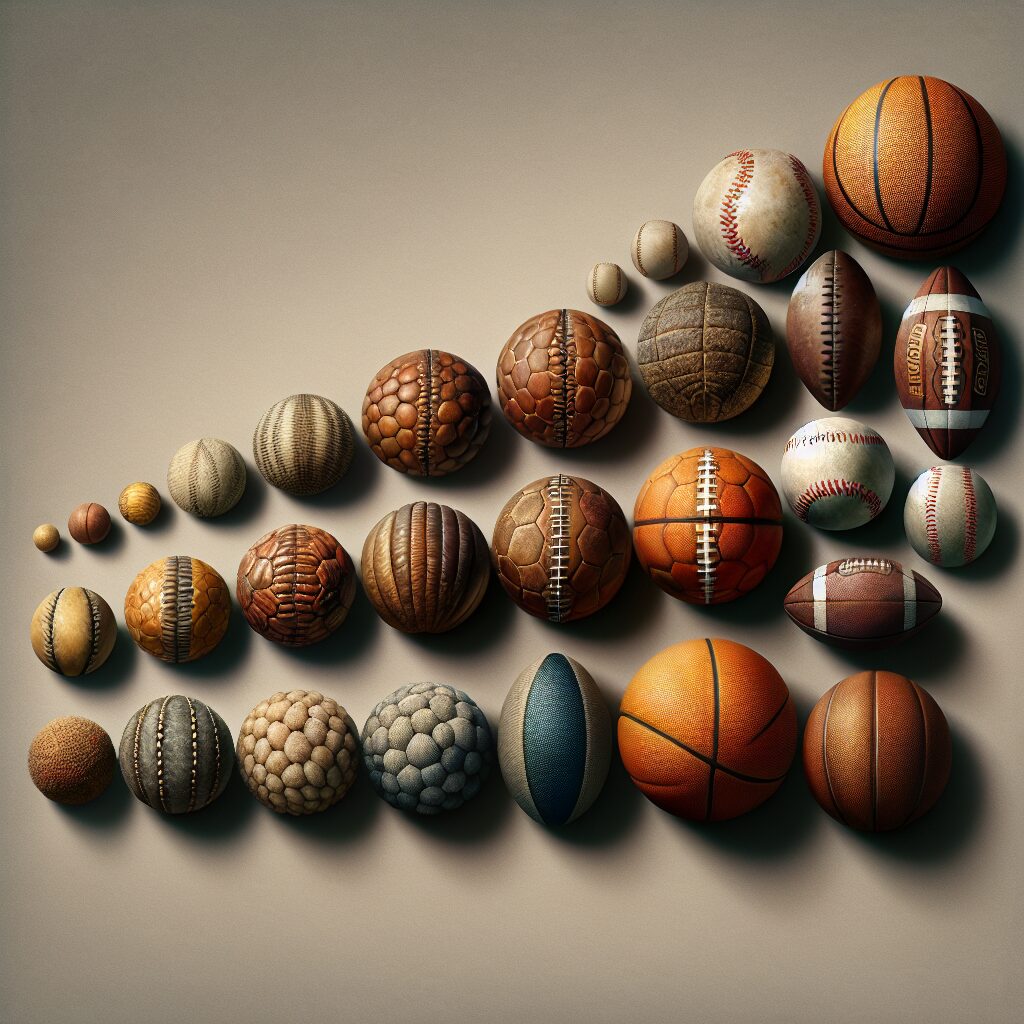The Evolution of Ball Design: From Past to Present
With all the different sports played around the world, one thing remains constant – the importance of the ball. Whether it’s a soccer ball, basketball, or even a tennis ball, the design and construction of these sports essentials have come a long way. From the materials used to the way they are manufactured, the evolution of ball design has had a significant impact on the way we play and enjoy sports.
One fascinating aspect of ball design is the incorporation of technology. Gone are the days when balls were simply made of animal bladders or stitched leather. Today, materials such as synthetic rubber, high-performance polymers, and even microfiber materials are used, enabling better durability, grip, and performance. Improved aerodynamics and better weight distribution have also played a vital role in enhancing the overall playing experience. As a result, athletes have been able to achieve higher levels of precision, accuracy, and control in their respective sports.
Now, let’s dive into the key takeaways from the evolution of ball design. We will explore the impact of technological advancements, the role of aerodynamics, and how materials have revolutionized the way balls are constructed. Additionally, we will discuss the influence of ball design on athletes’ performance and the future possibilities in this ever-evolving field. So, let’s grab our seats and embark on a journey through the fascinating history and advancements of ball design!
Key Takeaways
1. The evolution of ball design has been driven by changing needs and improvements in technology, resulting in balls that offer better performance and meet specific sport requirements.
2. The use of different materials has played a crucial role in the development of ball design, with advancements in rubber, leather, synthetic fabrics, and polymers enhancing durability, control, and aerodynamics.
3. The shape and size of balls have also evolved over time, with sports like soccer transitioning from irregular shapes to more standardized designs for fair competition and consistent gameplay.
4. The incorporation of advanced design features, such as dimples on golf balls or panels on soccer balls, has significantly influenced their aerodynamics, enabling greater distance, accuracy, and control in various sports.
5. Ongoing research and innovations continue to drive ball design, with the exploration of smart technologies and advanced materials holding the potential to further improve performance, safety, and even enable new functionalities in the future.
What is the Significance of The Evolution of Ball Design: From Past to Present?
The History of Ball Design
In this section, we will delve into the origins of ball design, tracing its evolution from ancient times to the present day. We will explore how different materials and technologies have influenced the design and performance of balls used in various sports and recreational activities.
The Role of Materials in Ball Design
Here, we will discuss the importance of different materials in ball design. From natural materials like animal bladders and tree sap to modern synthetic materials such as rubber and synthetic leather, we will examine how material choices have affected aspects like durability, bounce, and grip.
Innovations in Ball Manufacturing Techniques
This section will focus on the various manufacturing techniques that have contributed to the evolution of ball design. We will explore the advancements in molding, stitching, and bonding methods that have allowed for the creation of more uniform and aerodynamic balls.
The Impact of Ball Design on Sports Performance
Here, we will discuss how changes in ball design have affected sports performance. We will analyze the influence of factors such as ball weight, shape, and surface texture on aspects like distance, accuracy, and control in different sports such as football, basketball, and golf.
The Future of Ball Design
In this section, we will speculate on the future direction of ball design. We will explore emerging technologies, potential advancements in materials, and innovative concepts that could shape the next generation of balls. From smart balls with embedded sensors to environmentally friendly materials, the future of ball design holds exciting possibilities.
6 Tips for Making Informed Decisions in Ball Design:
- Consider the specific requirements and constraints of the sport or activity for which the ball is intended.
- Research the latest advancements and trends in ball design to stay ahead of the curve.
- Consult experts in the field of materials science and sports engineering for insights and advice.
- Test and gather feedback from players or users to assess the performance and satisfaction with the design.
- Explore sustainability options and choose eco-friendly materials and manufacturing processes.
- Continuously iterate and improve ball design based on user feedback and technological advancements.
Frequently Asked Questions
1. What is ball design evolution?
Ball design evolution refers to the process of how the design, materials, and technology used in creating balls have changed and advanced over time. It includes improvements in aerodynamics, durability, performance, and other aspects.
2. What are the factors that drive the evolution of ball design?
Several factors play a crucial role in driving the evolution of ball design. These include advancements in materials science, increased understanding of aerodynamics, the need to enhance player performance, and the desire for increased durability and consistency.
3. How have the materials used in ball design evolved?
The materials used in ball design have evolved significantly. In the past, balls were commonly made from natural materials like animal bladders and leather. However, modern balls are typically made from synthetic materials like polyurethane, rubber, or a combination of different materials, which offer enhanced durability and performance.
4. What are the major changes in ball design over the years?
Over the years, there have been numerous significant changes in ball design. These include advancements in panel construction, introduction of new aerodynamic patterns, adoption of seamless designs, inclusion of microtextures for improved control, and the use of advanced bladder systems for better air retention.
5. How has ball design impacted sports performance?
Ball design has had a significant impact on sports performance. The evolution of ball design has led to improved aerodynamics, allowing for better precision and control. Additionally, advancements in materials have enhanced durability, grip, and rebound, enabling athletes to achieve higher levels of performance.
6. What role does technology play in the evolution of ball design?
Technology plays a crucial role in the evolution of ball design. Advanced testing methods, such as wind tunnel testing and computer simulations, allow researchers and manufacturers to analyze and optimize ball design for optimal performance. Additionally, technological advancements have facilitated the development of new materials and manufacturing processes.
7. Are there any drawbacks to the evolution of ball design?
While the evolution of ball design has brought many advantages, it is not without drawbacks. Some argue that modern balls may lack the traditional feel and character associated with older designs. Additionally, the increased complexity and cost of manufacturing advanced balls may make them less accessible to certain segments of the population.
8. How does the evolution of ball design impact the environment?
The evolution of ball design has both positive and negative environmental impacts. On one hand, the use of synthetic materials reduces the reliance on animal-based materials, which can be more sustainable. On the other hand, the manufacturing processes and disposal of modern balls may contribute to environmental pollution and waste.
9. What is the future of ball design?
The future of ball design is likely to continue pushing the boundaries of performance, durability, and sustainability. Advancements in materials science, including bio-based materials and nanotechnology, may lead to even more innovative designs. Additionally, advancements in sensor technology and connectivity may enable the integration of smart features into balls.
10. How does ball design impact different sports?
Ball design has a significant impact on various sports. Different sports have unique requirements in terms of size, weight, bounce, grip, and aerodynamics. By tailoring ball design to the specific needs of each sport, players can have an optimal experience and maximize their performance.
Final Thoughts
The evolution of ball design has revolutionized the world of sports. From humble beginnings to cutting-edge technology, the improvements in ball design have enhanced athlete performance, improved gameplay, and pushed the boundaries of what seemed possible. The combination of advancements in materials, aerodynamics, and manufacturing processes has paved the way for athletic achievements that were once unimaginable.
However, while progress is exciting, it is important to strike a balance between tradition and innovation. The nostalgia associated with certain ball designs should be respected, even as we embrace the opportunities provided by modern advancements. With a continued focus on sustainability and accessibility, the future of ball design holds immense potential to shape the way we play and enjoy sports for generations to come.




